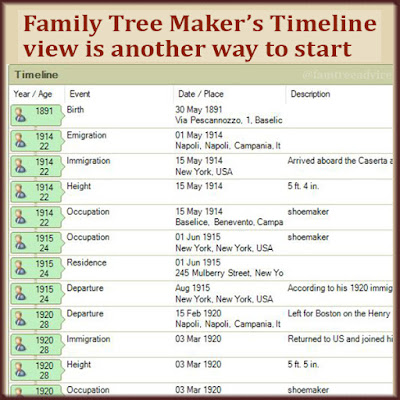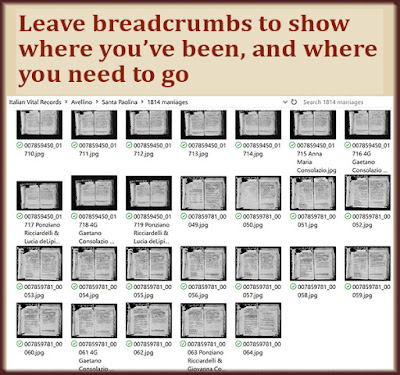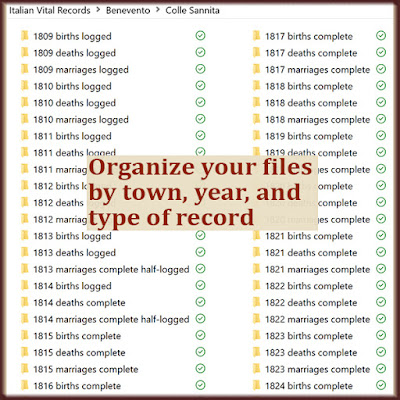Like any big puzzle, it helps to start with the edges and find pieces that fit one another.
Last time, I told you about a DNA color-clustering method. It shows you visually how you're connected to your DNA matches. This method, and the online tree of a crucial DNA match, showed me where I need to focus. Right down to a specific last name.
You see, my parents share DNA. This was a surprise to them, and I'm eager to be able to show them exactly which set of ancestors they share.
I'm focusing on the last name Pozzuto in the town of Colle Sannita, Italy. There were a lot of people in town with that name. And they must have been distinct families, because a high number of men married women with the same name.
I began by looking at the parents of one key DNA match, both named Pozzuto. The tree is not well sourced, and much of the information comes from my 97-year-old DNA match herself.
 |
| I have 77 people in my tree with this last name, but that's not enough pieces for this puzzle. |
I turned to the massive collection of Italian vital records that I have on my computer. When you've got all your ancestral town's documents on a local drive, research is fast and easy. (Find out how you can download a collection like mine.)
I've been trying to confirm the names and birth dates of the people on both sides of the Pozzuto-Pozzuto tree. I find a person's birth record, then try to find their father's birth record and their grandfather's birth record. The goal is to identify someone who is already in my tree with a blood relationship.
After adding several people to my tree this way, I realized something. I have a cousin in Italy who's about my age and is named Pozzuto. His mother's side of the family is related to my father's side of my family. So his being a Pozzuto is a coincidence.
But…I've always thought he looks like my cousin on my mother's side of my family. What if this cousin, related to my dad but with a resemblance to my mom, is the key?
I started digging into the little bit of information he'd given me about his father. I quickly found his father's parents' 1932 marriage documents. I learned my cousin's grandparents' names and kept going until I had some of his great grandparents' names.
But I couldn't tie this Pozzuto family to that of my DNA match. Time for a new strategy.
Last summer I read about a genealogist's massive effort to build out family trees for everyone in his DNA match list. I think the Pozzuto family is my key. Why not put together every Pozzuto family sitting in my collection of vital records?
That's how I built a tree of 15,000 people from my maternal grandfather's hometown. I took the information from each vital record and entered people into a Family Tree Maker file. I placed babies with their parents. I found the parents' marriage records and gave them their parents. After a while, all the families fit together.
 |
| These are some of the files I've identified with this name so far. Lots more work to do! |
I'm going to pick a year, like 1860, and find each Pozzuto baby born in the town. I'll put them in my tree and give them my "no relationship established" marker (find out why that's important). As I go from year to year, I'll find babies that are siblings to the babies I found earlier. I'll build each family.
This will take lots of hours, but I'll wind up grouping together Pozzuto families. Some of them will be people I have in my tree already. Eventually I will find a direct line to my DNA match.
Still, that's not the goal. I need to find someone in that gene pool who married someone with a last name from my mother's side of the family.
All my ancestors came from neighboring towns. The prospect of marrying someone from the next town is very real. I've seen it. I'm eager to find a girl from Colle Sannita who married a guy from either Baselice or Pastene (most likely).
It's exciting to have all those documents waiting for me to read them. The answers are there! I simply need to dig and dig until I find them.
Can you do this with your ancestors' towns and your DNA matches?
And speaking of piecing together families:



















